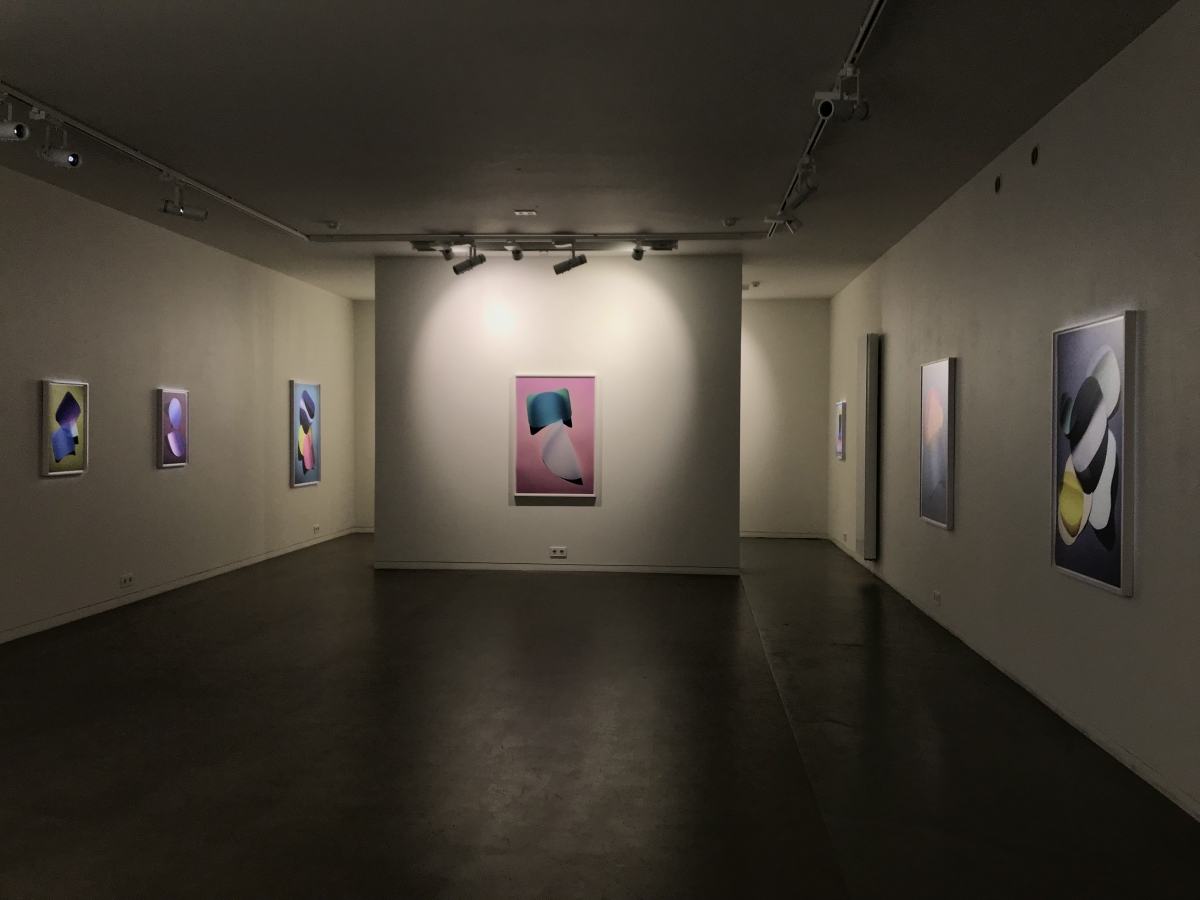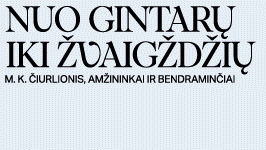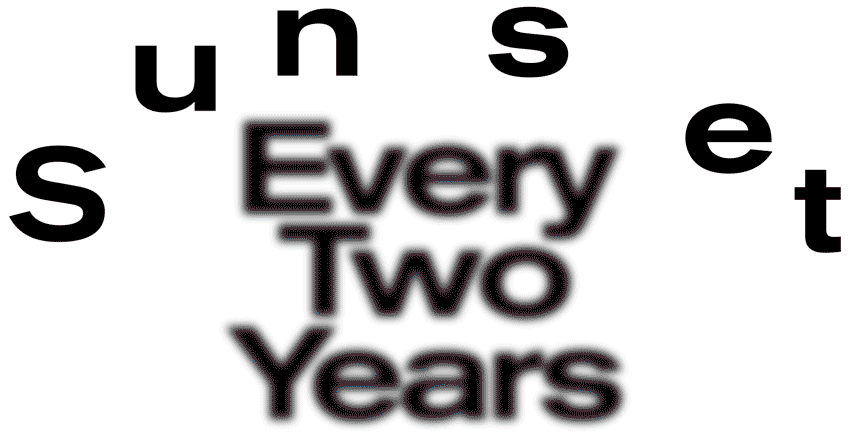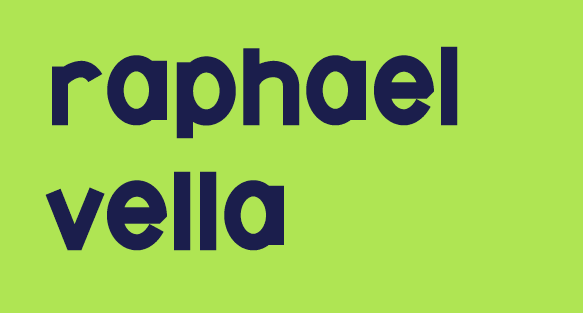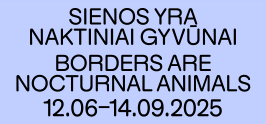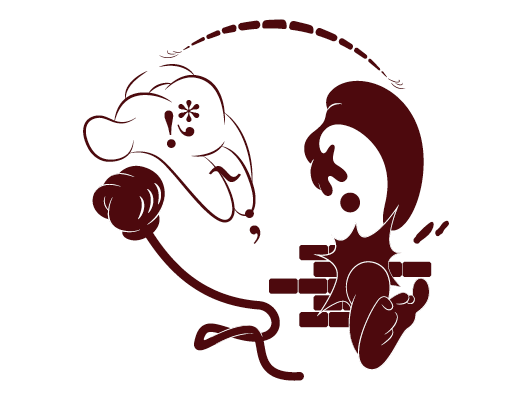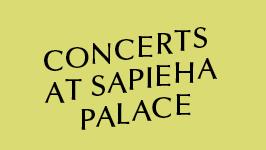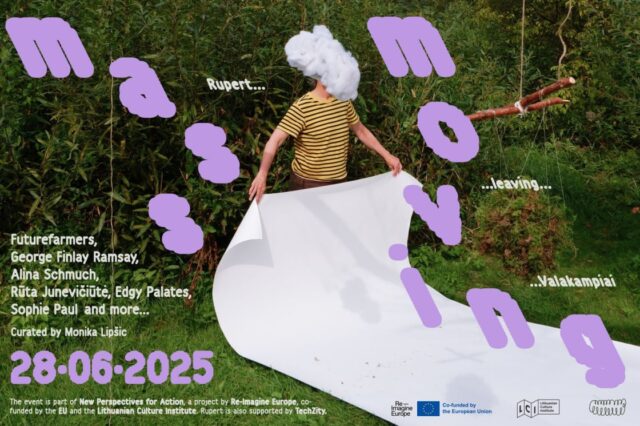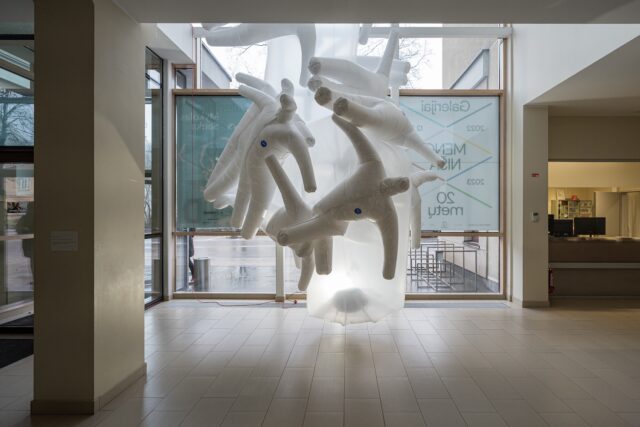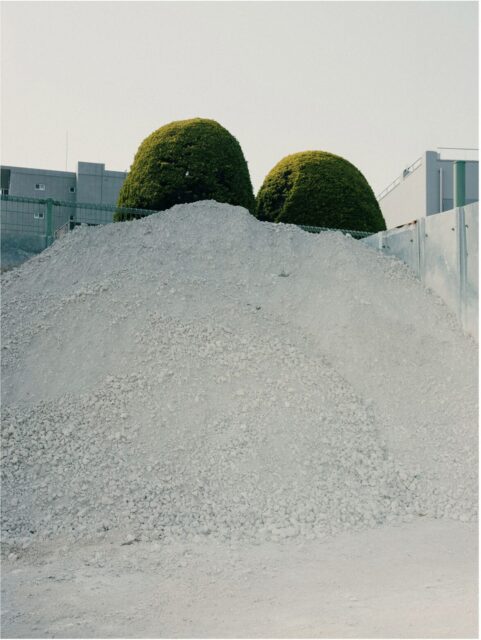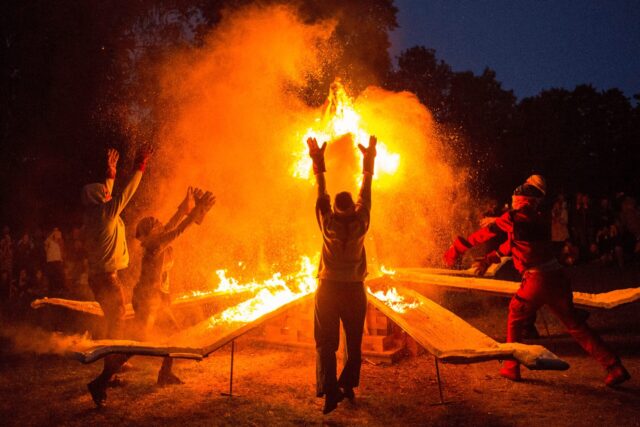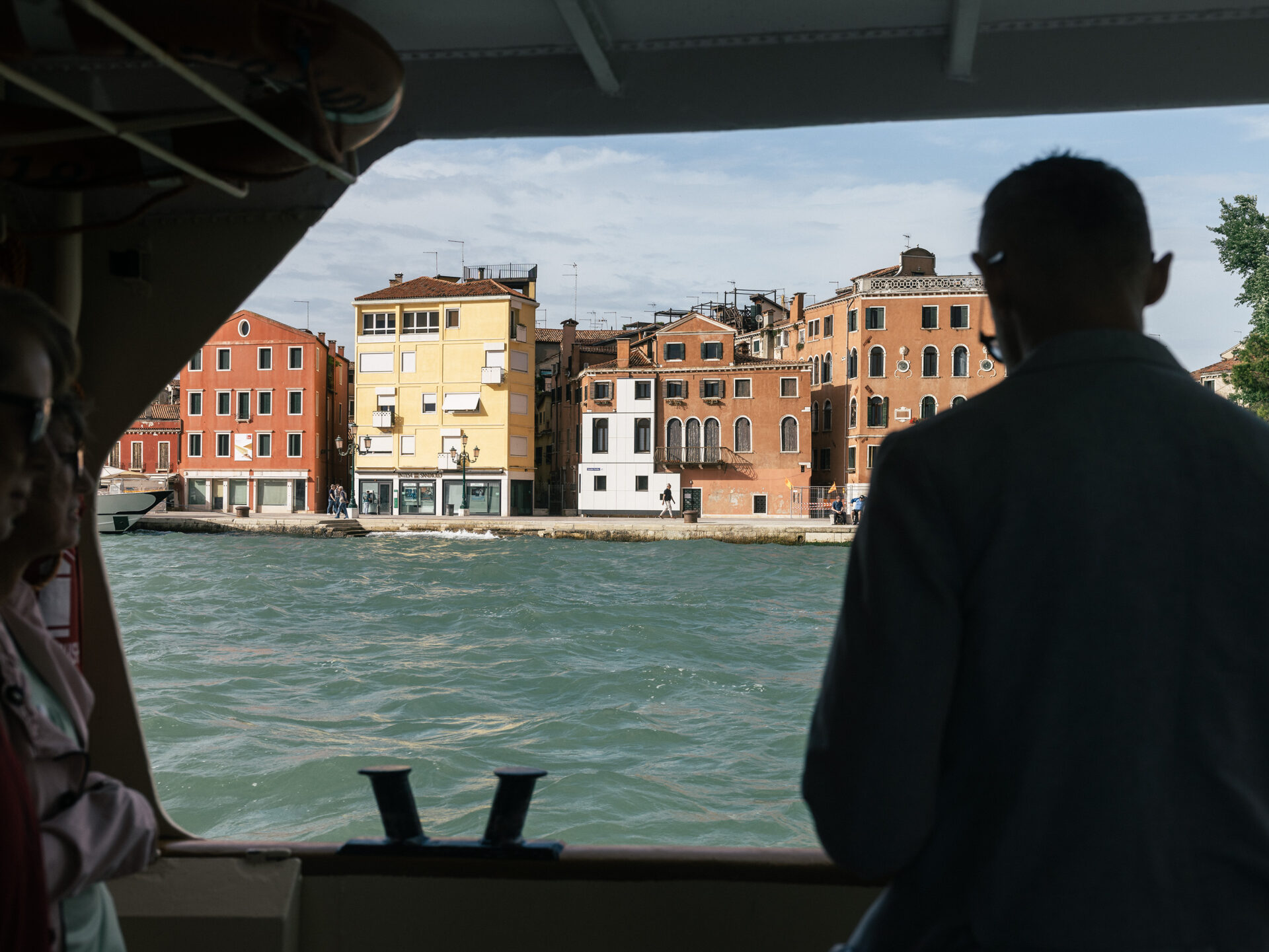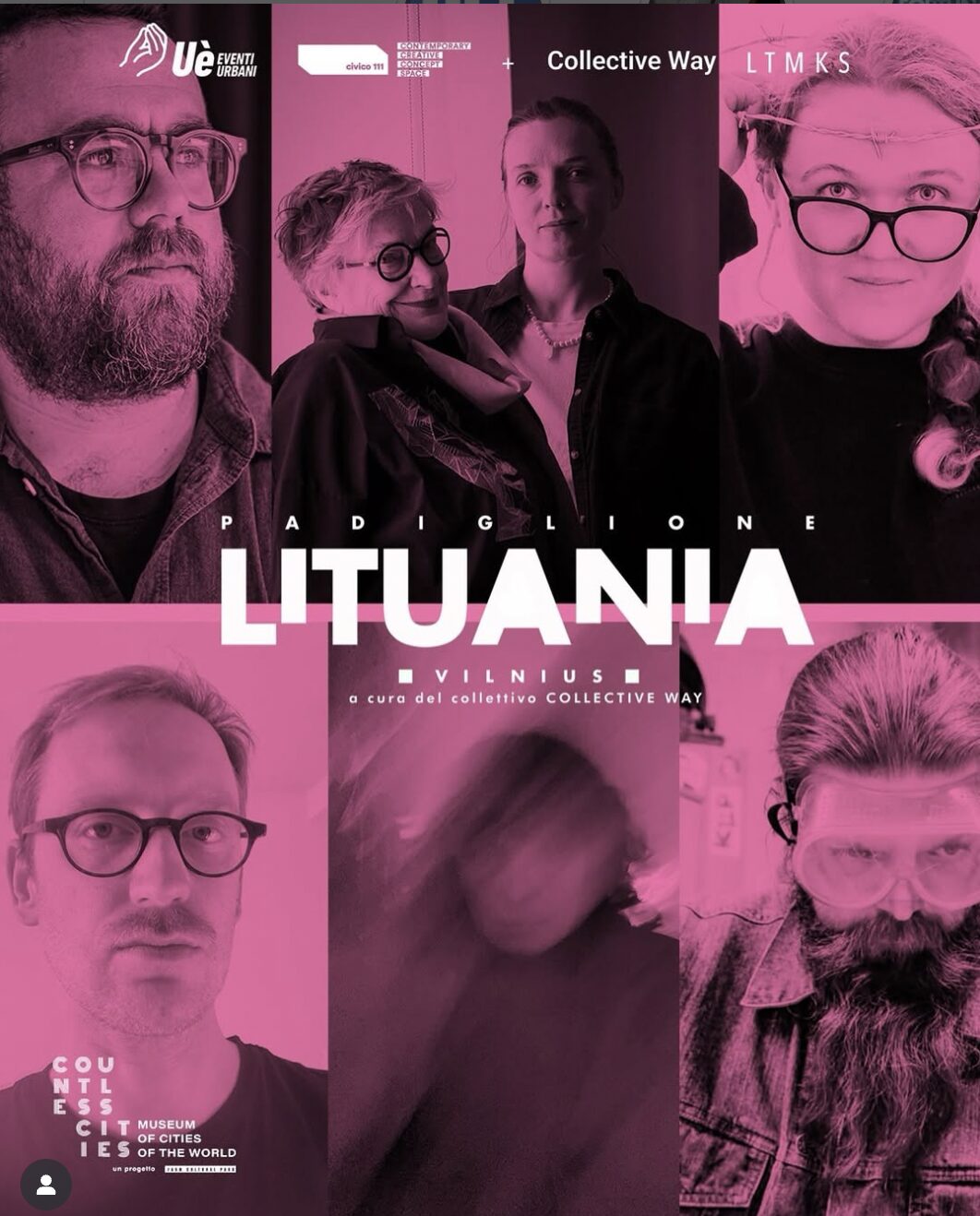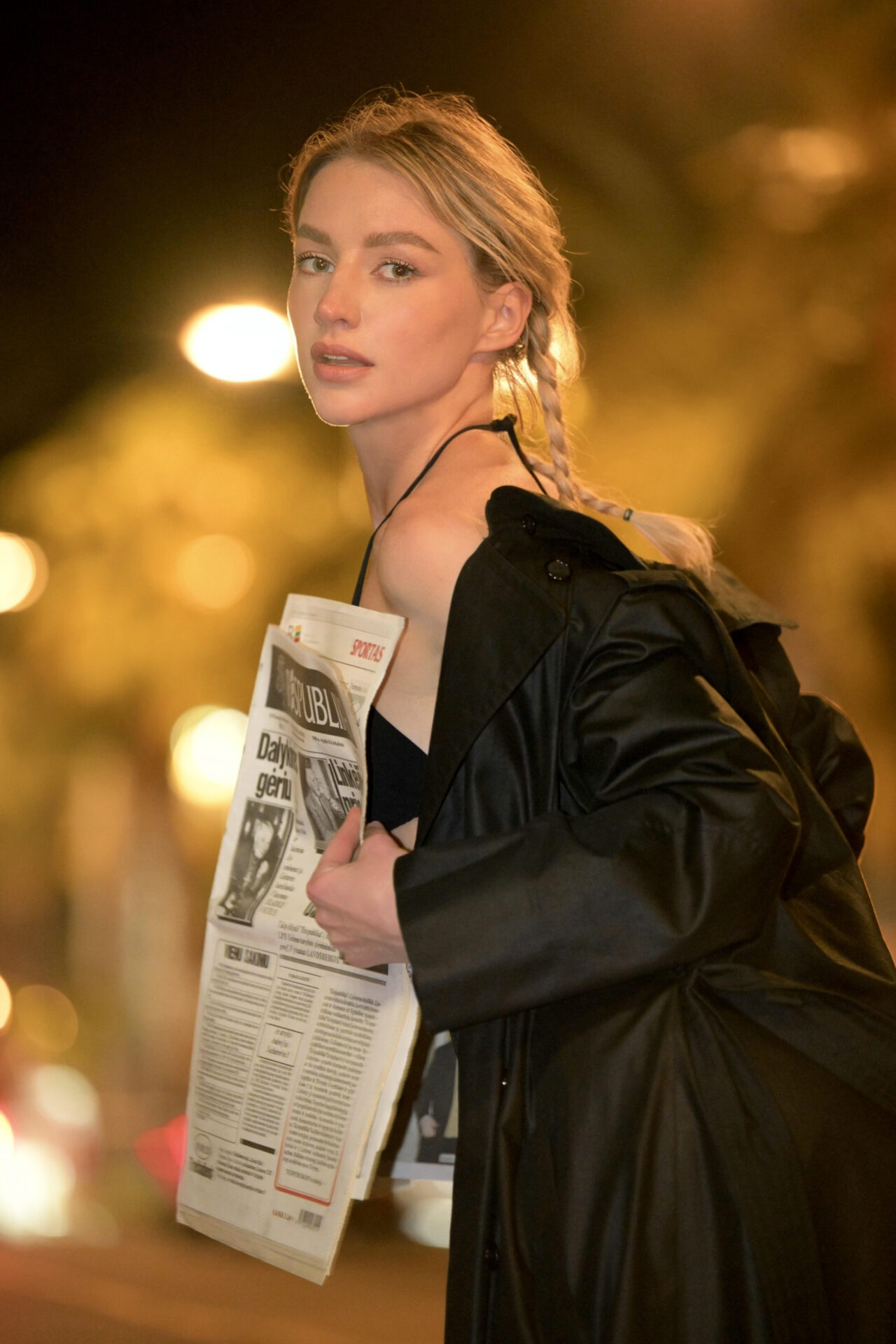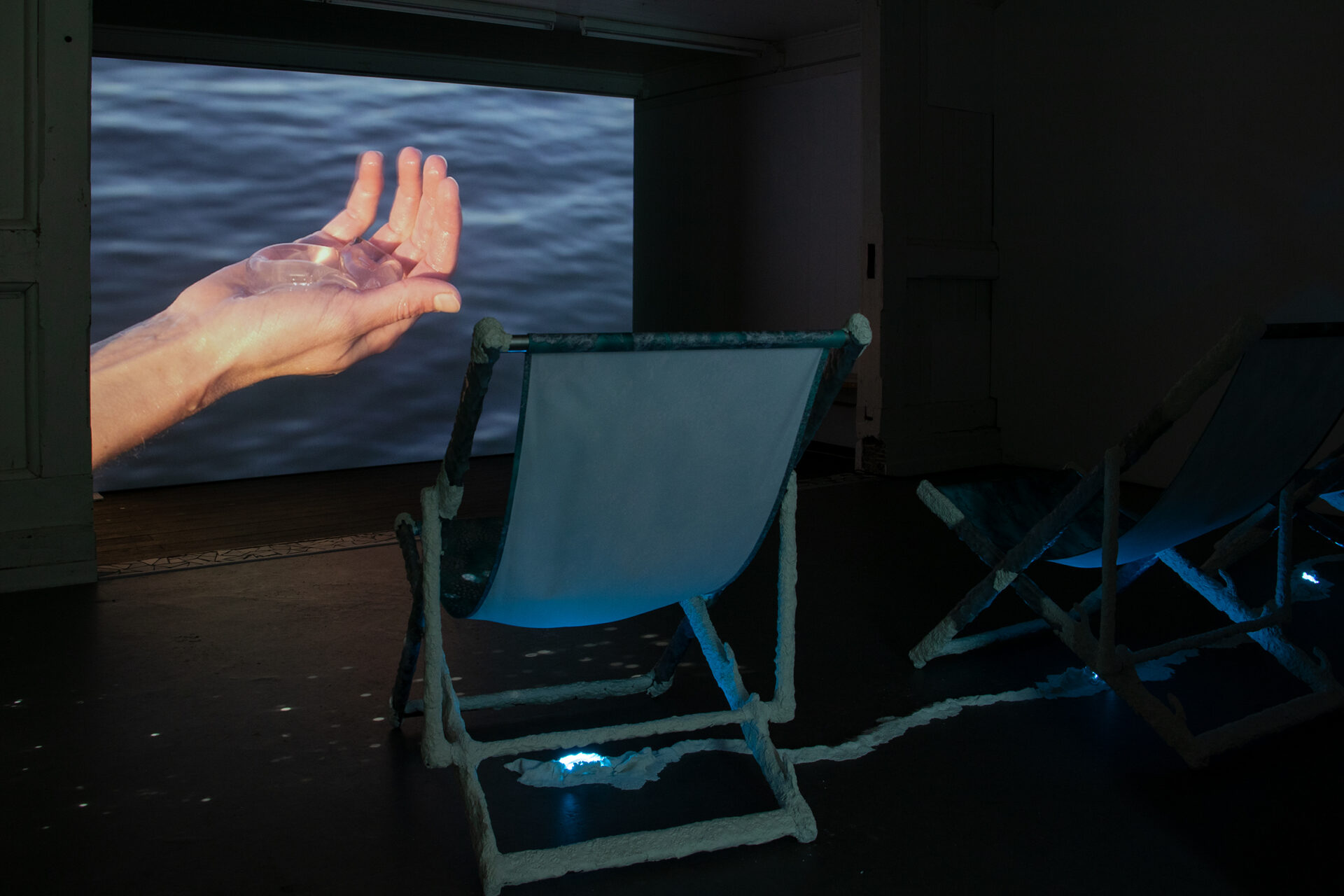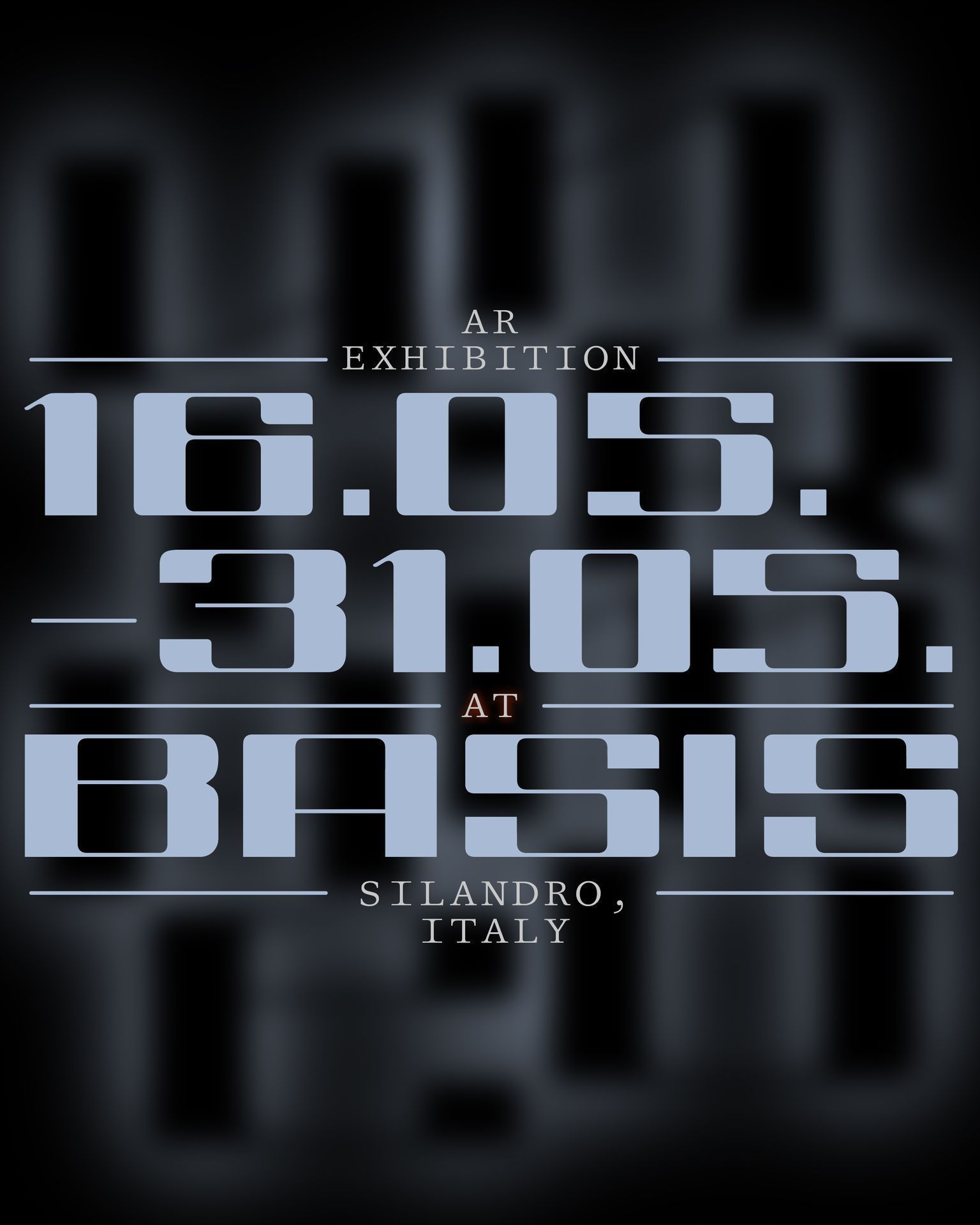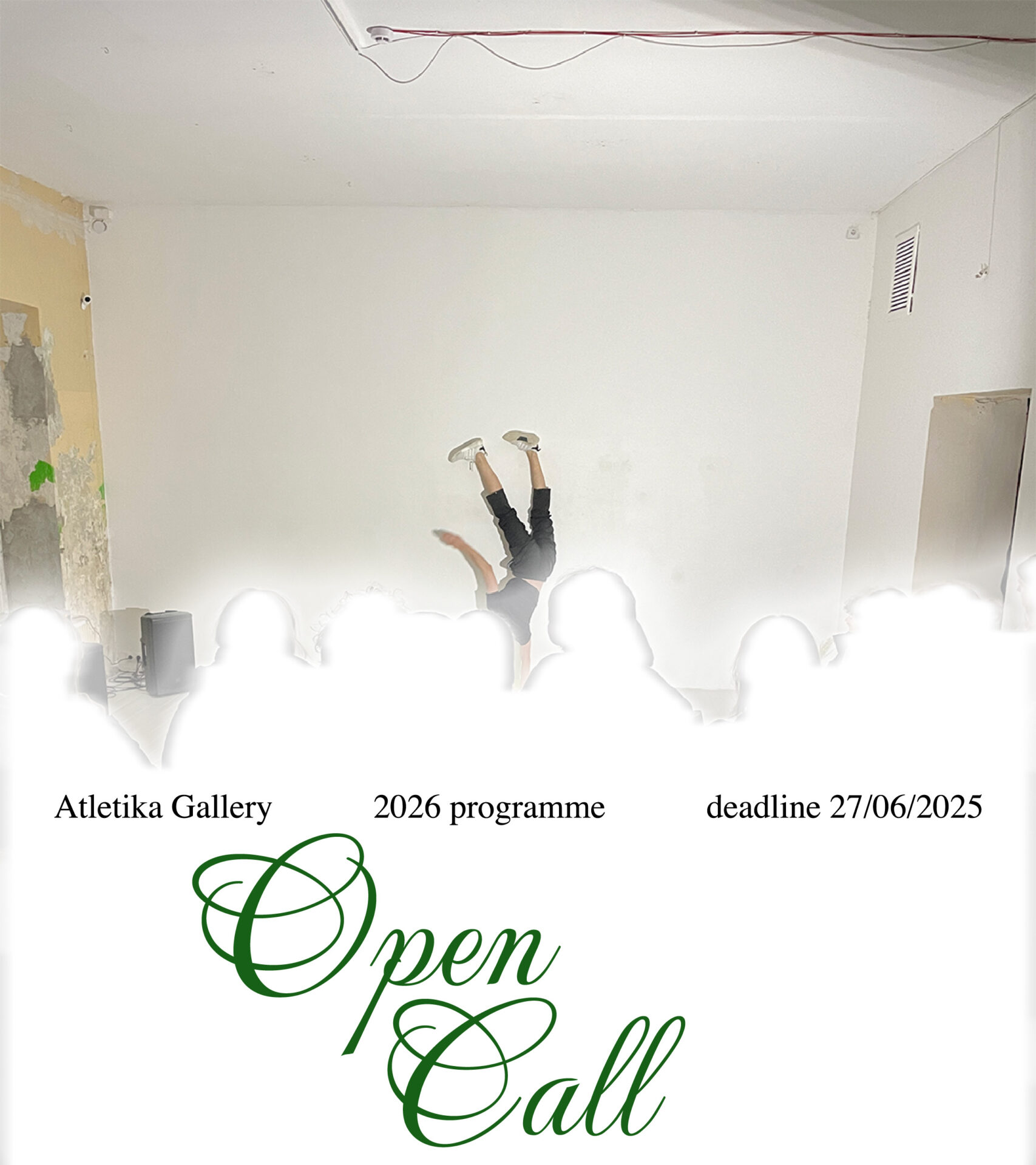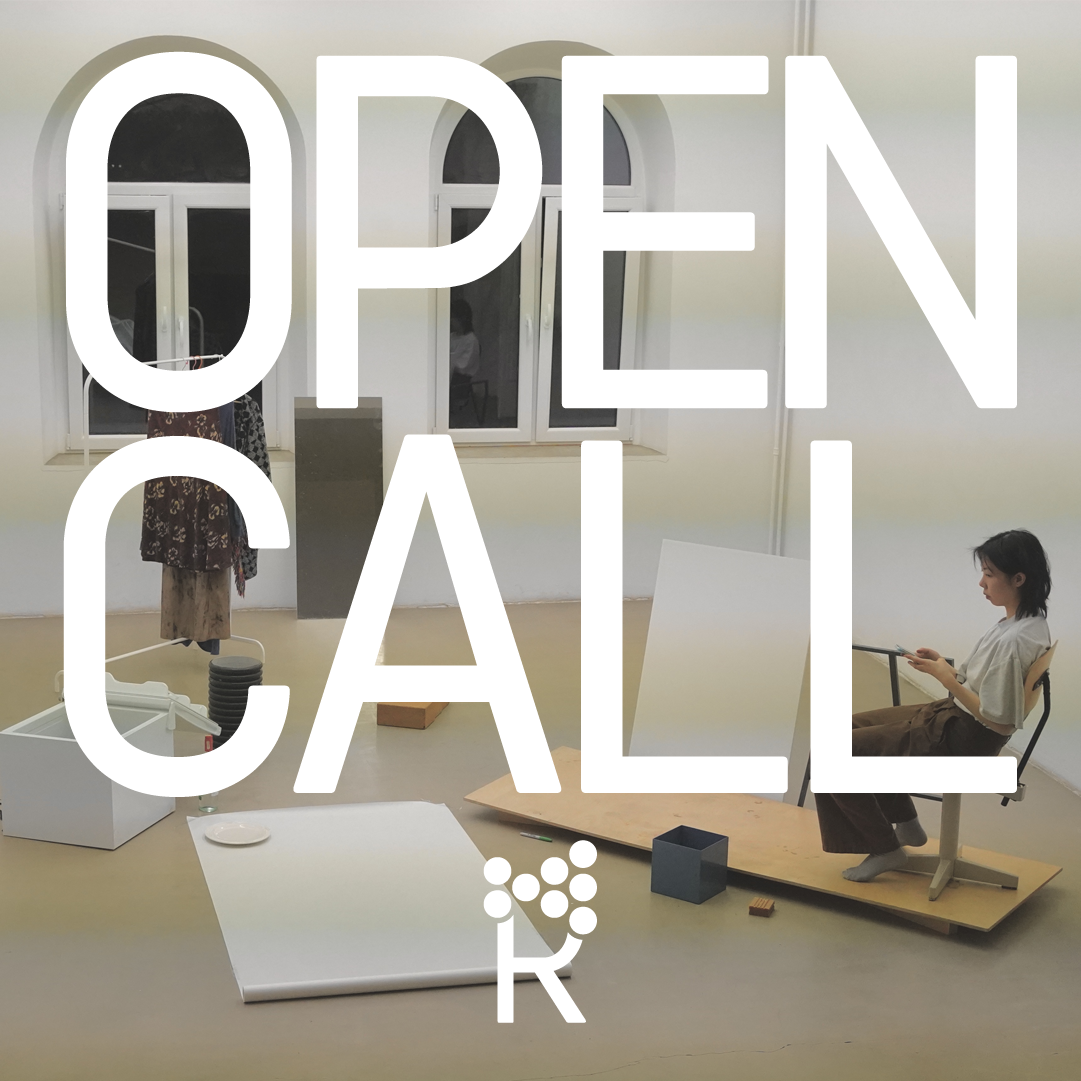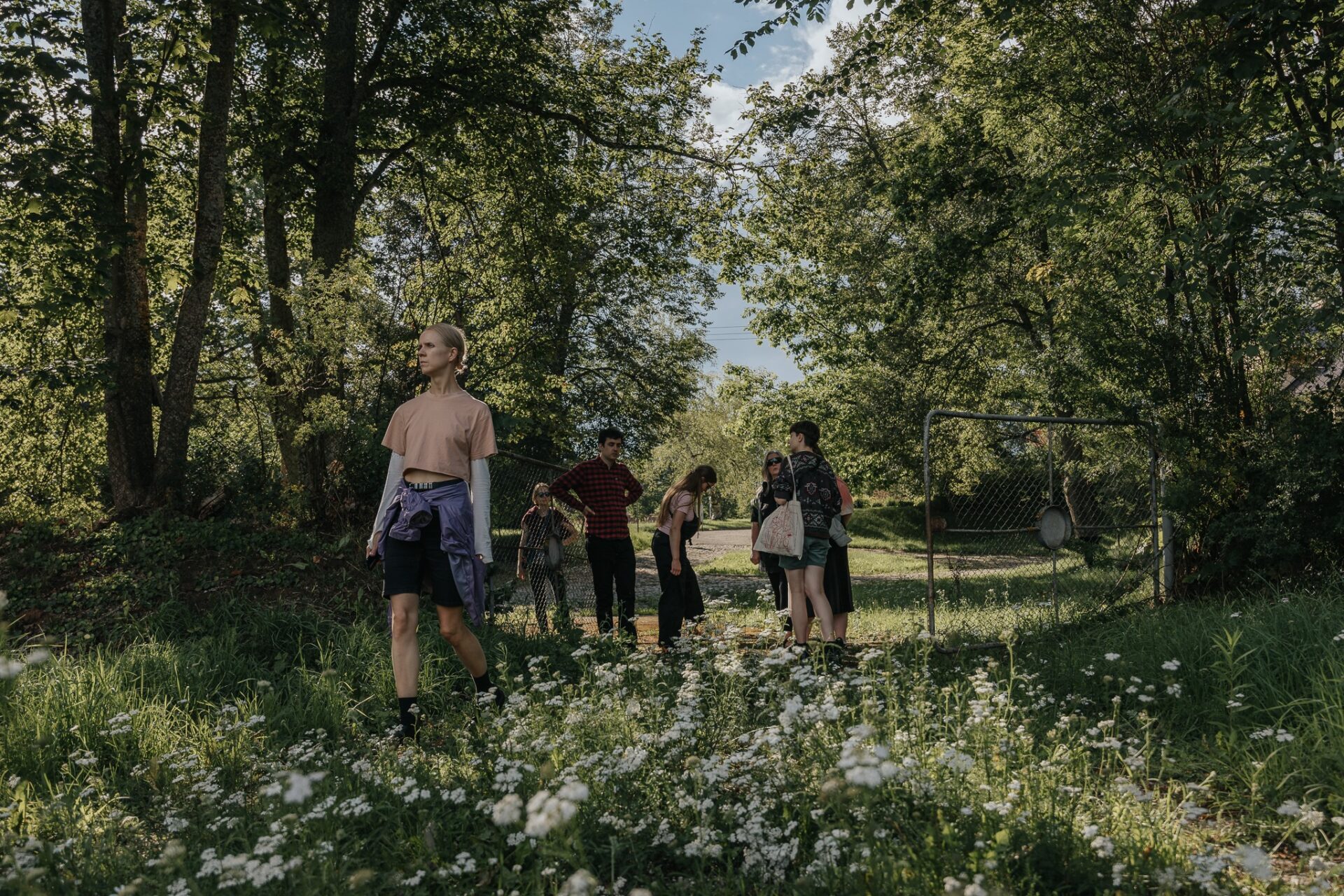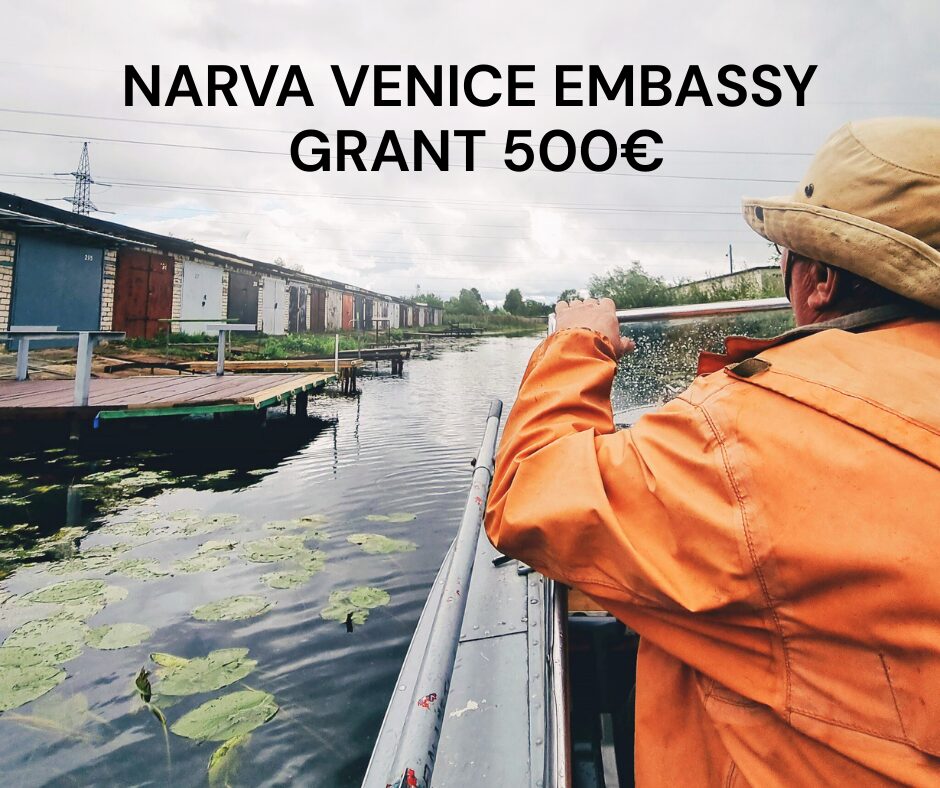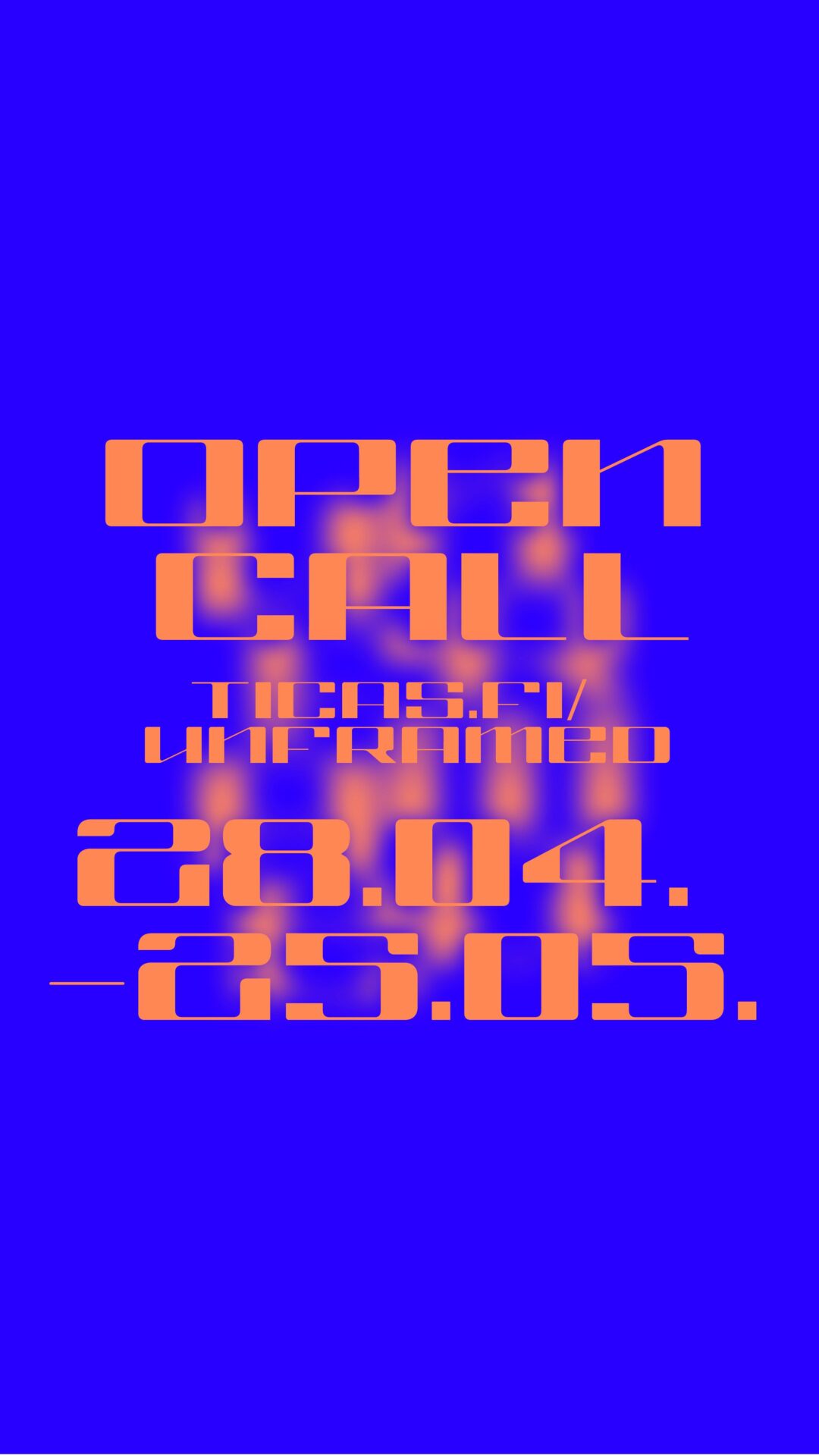As I write these lines, it’s the last day of the exhibition ‘Cut Outs’ by the prominent visual artist Jessica Backhaus at the Prospektas Gallery in Vilnius. The pictures are created by the simplest means, and they reduce photography to its basic elements: light and shade, shape and colour. Cut-out transparent paper reacts to the heat of intense sunlight, it deforms, rises and casts shadows. The photographer, who arranged and staged these compositions, becomes the astonished observer of events over which she has only limited influence, the documenter of a visual experimental arrangement, a poetic choreography of intense colours in the sunlight.
Jessica Backhaus was born in Cuxhaven, Germany, in 1970. At the age of 16, she moved to Paris, where she later studied photography and visual communications from 1989 to 1992. In 1995, her passion for photography drew her to New York, where she lived until 2009. Backhaus is regarded as one of the most distinguished voices in contemporary photography in Germany today. Her work has been shown in numerous solo and group exhibitions, including the National Portrait Gallery, London, the Martin-Gropius-Bau, Berlin, MARTa Herford, Herford and the Kunsthalle Erfurt, Erfurt. To date, she has ten publications to her name, and is represented by various galleries in Europe and the USA.
In September, Backhaus participated in the 45th International Photography Symposium in Nida, a photography meeting traditionally held by the Lithuanian Photographers Association in the most remote point in Lithuania between the Curonian Lagoon and the Baltic Sea. Backhaus was invited to introduce herself and conduct the workshop ‘About Intuition and Visual Poetry’. Before our conversation in one of the traditional-looking fishermen’s houses in Nida, I watched the artist experimenting with tea herbs on oldish photographic paper.

CUT OUTS by Jessica Backhaus
Domininkas Kunčinas: Let’s go back a few decades. What was the first photographic image to stick in your mind?
Jessica Backhaus: One image struck me when I was an 18-year-old photography student, and that particular image is still one of my favourites. It’s the picture Three Boys at Lake Tanganyika, taken by the Hungarian photographer Martin Munkácsi, in 1930, I believe. It’s an image of three young boys running into the water, and it is so magical, such a profound and magical photograph. And it’s an image that has never truly left me, because it’s very graphic, and the composition is just exquisite. The emotion I get from it is so powerful.
Some years later, in 1992, I befriended the photographer Gisèle Freund. One day, Gisèle visited me in my new apartment in Paris, and said: ‘I have a gift for you.’ I thought, ‘Oh, maybe a print from her?!’ I opened the box, and, you won’t believe me, but there was that particular Munkácsi print. I was speechless, because I’d never spoken to Gisèle about my passion for that image. And I wondered: ‘How come you are giving me this image?’ And she said: ‘Well, I was in Switzerland and saw it in a gallery. This image reminded me of you and the passion you have for life.’ I didn’t want to show her my work and we had some arguments about it, but in a way it’s like great Greta Garbo asking a young actress: ‘Show me what you can do.’ I was too intimidated, and I wasn’t ready for her critique. I only showed her one particular image, taken in India, which, funnily enough, was inspired by Munkácsi, and it shows some naked boys running into a river near the Taj Mahal.
When I was working on my project one day in November, I did a lot of research, and also about this photograph in particular. I found out it was the photograph that inspired Henri Cartier-Bresson to become a photographer. He said: ‘In 1932, I saw a photograph by Martin Munkácsi of three black children running into the sea and I must say that it is that very photograph which was for me the spark that set fire to fireworks. I suddenly understood that photography can capture eternity in one instant. It is only one photograph that influenced me. There is in that image such intensity, spontaneity, such joy of life, such prodigy, that I am still dazzled by it even today.’ It’s a beautiful quote. And the image is an iconic photograph.
DK: You grew up in an artistic family: what did your parents do?
JB: It was a very colourful childhood, because my mother is an actress and my father was a director, so we were always going from theatre to theatre, living in different cities. There was a lot of love and openness. Our home was always full of actors, singers and performers. My parents were absorbed by the theatre, so they taught me to be independent from a very young age.
DK: Did they encourage your artistic ambitions, or did they want you to be a doctor or a lawyer?
JB: No, they definitely didn’t say that. But my mother, when I told her that I wanted to become a photographer, was very sceptical and critical. She said: ‘Are you sure you want to go down that path? You will live a little bit on the edge. There’s no security. So you will have to be very strong to do that, strong in the way that you have to be ready for all the rejection that will come your way.’
You know, if there is failure and rejection, I just have to deal with it, but I can’t stop. When I look back at my career until now, there were moments when it was very hard. And I think that what saved me from not giving up is the passion I have for photography. Creation is a need for me. My parents have been very supportive of my work, although at the beginning it was more like, are you sure you want to do this? Because they knew how hard it is.
People think photography is glamorous and it’s easy to be an artist. But, you know, the brutal truth is, it’s really hard. Things take time to develop. When I work with students, they say: ‘Oh, I want to have this and I want to have that.’ Well, of course, we all want to have certain things, but I always tell them to do everything step by step, because it’s not a marathon. You don’t simply choose a profession. I believe you choose a particular life that you want to live.
DK: And was photography your first passion?
JB: It was my second. A lot of people ask me if I wanted to be an actress. It’s the obvious question: ‘Why didn’t you follow in your mother’s footsteps and become an actress?’ It’s a long story, but I wanted to become … a dancer! When I was a child I was influenced by an American television series called Fame. It’s about a dance school in New York. I was mesmerised and wanted to become a dancer, but my mother said: ‘Unfortunately, you’re already too old, because you need to start when you are three or four, and you really need to apply strong discipline.’ I didn’t want to become a ballerina, not by any means, I wanted to do more contemporary modern jazz, but it’s another level to do that.
It was more a childhood dream. And then afterwards, when I was in my teens, I let it go. In the end, I realised it was photography, maybe because of growing up in the theatre and often being in the dark. After school I always went to the theatre, and I had to do my homework, which I didn’t want to do. I was more interested in observing what was going on on the stage. And then later, when I moved to Berlin with my mother, her partner had a television and movie archive, so I spent my teenage years there.
My first camera was given to me by the partner of my mother, and it was an Agfa Colour – Agnar Optima 1:2.8/45. I started using it in a conscious way when I was 14. I’ve always been submerged in visuals, and when I was about 17 the strong desire to become a photographer was born.

CUT OUTS by Jessica Backhaus
DK: From Germany you moved to Paris, and then to New York. How have these places influenced your visual perception? For example, in one interview, you said that in New York there is a particular light you find very inspiring.
JB: Well, you can find magical light situations in many places, but there is a particularly beautiful light in New York. I had conversations about it with Gisèle, because she used to live in New York at some point too. Even during the winter there’s always this crisp, sharp light. It has very strong shadows, and that light is filled with a particular energy.
Being a student in Paris was something very exuberant. I left Germany when I was 16 and spent eight years in France studying and working. In France they really celebrate photography. There’s so much culture and history in Paris, so it was really special to dive into that world while a student. But I must say it was quite difficult, because when I finished my studies in visual communications, photography and some journalism, I didn’t feel I knew anything. I thought I’d made the wrong choice. I would have chosen something different if I could do it all over again, a proper art school. So I really had the desire to learn more about photography, but, like everyone else, I had to make a living. I was naive. I thought: ‘Oh, I’m going to make a living with my photography. It didn’t work at all. So I became a photograph editor, and worked with art directors on magazines. Those two years were an incredible school in terms of editing: the art director gives you ten thousand slides, from which to pick the ten best ones to create a story.
But then I also wanted to learn more about lighting and the various techniques and cameras. I wanted to be an assistant, and at that time in Paris, being a woman, it was very difficult. I happened to be working with an American photographer, and once he said: ‘Why don’t you come to New York with your energy?’ Funnily enough, when I was very small, I fantasised about living in Berlin, Paris and New York. I thought: ‘Okay, I’ve done Berlin, I’ve done Paris, and now I have the opportunity to go to New York. Let’s go!’ I really didn’t think twice. I packed all my bags in Paris and just left. At the beginning, I thought I was going to stay for three months, as I had savings for that much time, but in the end I spent fourteen years there.
To this day, New York is part of who I am. It influenced me tremendously, in work, in discipline, in passion. Some of the photographers I’ve worked with opened up a whole world of art in a bigger sense. The museums there, it was something so special, so unique, that you had access to. Even my first works were influenced by some American photographers. But also New York itself, just that energy, the possibility you feel there, you can really try things, it’s truly unique.
Nevertheless, after fourteen years, I felt I needed to go back to Europe, because New York is so intense. The relationships you can develop in Europe are different. But even though I’m back in Berlin now, New York is still always with me. And Paris, in a way, too. I care deeply for both places.
DK: After you came back to Europe, the direction of your photography changed and turned more towards non-narrative photography …
JB: Immediately after I came back to Berlin I did a project called ‘Once, Still and Forever’. It was a project about some of the emotions I felt when I came back to Germany after having lived in foreign countries for twenty-two years. The work is still quite figurative, and has many still lives, but I could sense already then that at some point I would try to go in a different direction. Afterwards, I developed ‘Six Degrees of Freedom’, and I felt that would be more or less the last project which is more straightforward and where I was starting and trying to express myself in different ways. And my next project ‘A Trilogy’ was a kind of liberation from my own previous work because I felt the need to experiment and explore other areas in photography.
That was when I started to be more abstract, and when I also intervened and arranged some of the work, whereas before my rule was never to touch anything. I wanted to break it. If I wanted to move a cup, I simply wanted to give myself the freedom to move the cup.
Back in 2008, I had a conversation with Jean–Christophe Ammann, a curator who was very dear to me. He looked at my work, when I was fully emerged in figurative and still-life, and said, I don’t know if you’re going to believe me or understand, but one day you will end up in abstraction. I looked at him and wondered: ‘Why are you saying this? Look at my still-lifes: they’re very concrete.’ And he answered: ‘If you look carefully, there’s a profound longing for abstraction in your images, and you will end up there.’ Unfortunately, he passed away some years ago, so I can’t have any more conversations with him. But I wish I could show and share my work with him. He knew my work better than I did.
I still enjoy the figurative, but I long to be in abstraction more, because I find it challenging. I realise when you exhibit more abstract work people do not feel comfortable and at ease, because they don’t know what they’re looking at. Sometimes it even irritates them. But what I love about abstraction is that it allows you to have your own imagination. That’s the beauty of it: to have your own personal room, to feel, to think, to see whatever it is you want to see. I also believe it’s very difficult to do a good abstract work.
Basically, leaving the world of figurative, you’re going more and more into abstraction, and it’s like peeling away all the noise around you. You want to get to the core, to something a bit more radical and more minimal. I find that fascinating, but as with any creative process, you doubt, you question, you wonder … That’s how it is and should be.

CUT OUTS by Jessica Backhaus
DK: Sonia Delauney, one of your favourite artists, said that painting was like photography in colour … Is your photography turning into painting?
JB: I can honestly say that for the last, maybe, seven years, I’ve been much more inspired by painting and the visual arts in general. But I am a photographer, not a painter. I haven’t trained. But as I said earlier, I wish I could have gone to a proper art school. There are so many elements that I like about creation and art in a bigger picture. I have great admiration for how painters work, and there is such a broad range of techniques in painting. When I see some of their works, I think: ‘How on earth did they do that?’ Of course, it’s a much different process than taking photographs. I’m sure at some point I’m going to continue the artistic form of collage, which is really fascinating. I started experimenting with it in my project ‘A Trilogy’. I started with a photograph from my archive, and then I added other elements, found material, tape, paper, or liquid paint, whatever I had in my studio at the time.
And it’s so interesting, because it’s like a painter who has a white canvas and starts from emptiness, and then creates the work, but when to stop? Sometimes you can ruin everything so quickly if you put too many things on the collage. So it’s that fine balance of knowing that less is more. You have to see where to place the other element, if you add it or you don’t, what makes it emotional? What makes it a strong work? That’s something I want to continue to explore.
DK: You once talked about the power and the magic of colour. Can you elaborate on that?
JB: Well, for most of my life I’ve been drawn to colour. And even though I like some aspects of black and white photography, I really feel that colours are emotions, and in a way colours have their own particular poetry. The quote by Sonia Delaunay that I put in my latest book Cut Outs moved me so much. I wanted to start the book with her quote, because when you read what she said in 1949, there’s nothing to add: ‘Up to now, painting was like photography in color. But color was always employed as means to describe something. Abstract art is a premise of a liberation from the old pictorial formula. A genuinely new form of painting will emerge the day we understand that color has a life of its own, that the endless combinations of colors bear poetry and a poetic language way more expressive than the older forms. This mysterious language has to do with vibrations, the very life of a color. In this domain, new possibilities are infinite.’
Colours are a vital element, not only in my work but in my life. In our apartment in Berlin, every room has a different particular colour. Every object that we have in our home, be it a potato peeler or a candle holder, or whatever, has a particular colour. I’m so sensitive to colour that everything matters to me. And I express it in the way I live, how I like to dress, how I like to cover myself with colour, it has a huge influence on how I feel; and colours, also like music, help me to live. They help me to digest and process this world.
DK: There are so many visuals nowadays, we are flooded with them, and everybody’s an artist, everybody’s a photographer, everybody has his own fifteen minutes of fame. How do you feel in this visually noisy environment?
JB: I think I have an ambivalent relationship with all that. In a way, I find it fascinating. Just to talk about Instagram alone: it’s a love/hate relationship. I didn’t want do it for a long time. Why? What’s the point? Then somebody dear to me and some other colleagues said: ‘Why don’t you try, it’s great.’ At the beginning, I was very hesitant; but it has been a few years now, and I’m completely into it. Good things have come my way through Instagram. For example, I was invited to do a book publication by the Scottish publisher Iain Sarjeant from Another Place Press.
Like what you said, we’re submerged in this huge universe of images, everybody is constantly taking visuals and we’re diving into this world of pictures … and why not? But I also try, whenever I can, to forget that world completely. I need to distance myself and kind of get lost in my own bubble of isolation and silence. I remember having conversations with Gisèle Freund when I was young: she said, as an artist, as a photographer: ‘You’ve got to be educated, so read books, go to museums, look, go, listen. Seeing exhibitions: it’s like this wonderful nourishment.’
In the bigger picture, I think some elements of this digital world are making our society sick, as well, because we forget to look around, to speak with somebody in the real world. Sometimes, I believe, you have to step away from it all. Of course, the younger generation don’t know any other reality. For them, it’s part of their life from a very young age. I had my first mobile phone when I was forty. Now they have one when they’re ten years old. I must say I’m very grateful that I got to experience life with no email, no websites, no internet.
Anyway, I use my mobile like a sketchbook. If you want to create small formats, I think you can do beautiful work. I find it quite mesmerising how the camera operates in certain light situations. But if you want a different quality, of course, you need a proper camera, because you are very limited with the quality of the cellphone camera.
DK: And to finish, what would your advice be to a photographer just setting out?
JB: You need to be passionate, for sure. If you want to be in a creative field and you don’t have passion, you’re not going to make it. You’re not going to last. Because, as I said at the beginning, it’s really hard to make a living with your art. I was shocked because some years ago in a television documentary about the art world, they said that only three per cent are able to make a living from their art.
What is really important is that you invest yourself fully in your work. If you choose to go down that path, you have to be fiercely dedicated. I know it’s not easy to find a true dedication, because you have a life, you have responsibilities, you have a family, you have so many other things and obligations you have to deal with. So of course, it’s not easy to find that dedication, but in the end it’s all about making choices, and you can’t have it all sometimes. You choose and you also need a lot of patience. For me, creation is a need.
When we create, of course, we want to share our work. Then our ego wants to have success and wants to be recognised, but you also have to get used to the fact that not everybody will respond to your work, and not everybody will like it, and people will find it boring or irrelevant. You have to learn to live with that rejection or that critique or that indifference. In the end, what truly matters is the work, and you can’t give that up.
It’s complex advice, because there are so many elements that you need. Life is complicated, and at times we face challenges. But I think even the hardship is worth it, because when you create and you find something, allow yourself to follow your instinct and be guided by your intuition, you take a chance and you are daring … that whole process in itself is such bliss. It’s an exuberance that makes me fulfilled and makes me feel alive.

CUT OUTS by Jessica Backhaus

The exhibition CUT OUTS by Jessica Backhaus opens at Prospekto Gallery

The exhibition CUT OUTS by Jessica Backhaus opens at Prospekto Gallery

The exhibition CUT OUTS by Jessica Backhaus opens at Prospekto Gallery

The exhibition CUT OUTS by Jessica Backhaus opens at Prospekto Gallery

The exhibition CUT OUTS by Jessica Backhaus opens at Prospekto Gallery
